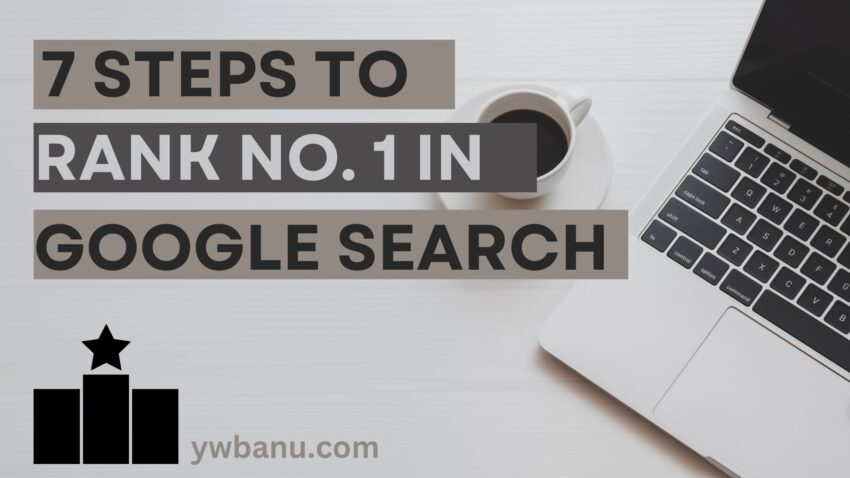Table of Contents
There are many factors that can influence your ranking in Google search results. Here are the 7 Simple Steps to Rank Number 1 in Google Search.
Use relevant, high-quality content
Google values content that is relevant, informative, and well-written. Make sure that your website provides useful and valuable information for your users.
Using relevant, high-quality content refers to providing informative and valuable information on your website that is relevant to the topic or purpose of your site. This means writing content that is well-written, well-researched, and accurate, and that provides value to your readers.
Having high-quality content is important for several reasons:
- It can help improve your ranking in search results: Google and other search engines tend to rank websites with high-quality content higher in search results.
- It can help attract and retain visitors: People are more likely to visit and spend time on a website that provides valuable and informative content.
- It can establish your website as a trusted and reliable source of information: Providing high-quality content can help establish your website as a trusted and reliable source of information in your industry or niche.
Optimize your website for mobile devices
With the increasing use of mobile devices, it’s important to make sure your website is mobile-friendly.
Optimizing your website for mobile devices involves making sure that your website is easy to use and navigate on mobile devices such as smartphones and tablets. Here are some tips for optimizing your website for mobile devices:
- Use a responsive design: A responsive design ensures that your website automatically adjusts to the screen size of the device it is being viewed on. This makes it easier for users to navigate your site on mobile devices.
- Keep your pages loading quickly: Mobile users are often on the go and may be using a slower internet connection. Make sure your pages load quickly to improve the user experience on mobile devices.
- Use larger font sizes: Small font sizes can be difficult to read on small mobile screens. Use larger font sizes to make your website easier to read on mobile devices.
- Make buttons and links easy to tap: Make sure that buttons and links are large enough and spaced far enough apart so that they are easy to tap on a mobile device.
- Optimize images for mobile devices: Large images can take longer to load on mobile devices, which can slow down your website. Optimize your images by compressing them and using the appropriate image file format (e.g., JPEG, PNG).
By following these tips, you can improve the user experience on your website for mobile users and potentially improve your ranking in search results. It’s important to note that mobile-friendliness is one of the factors that Google considers when ranking websites in search results.
Use relevant and descriptive titles and meta descriptions
The title and meta description of your website’s pages appear in search results, so they play a crucial role in attracting visitors to your site. Here’s why it’s important to use relevant and descriptive titles and meta descriptions:
- They help users understand what your page is about: A relevant and descriptive title and meta description can help users understand what your page is about and whether it’s relevant to their search query.
- They can influence a user’s decision to visit your site: A well-written and descriptive title and meta description can convince a user to click on your link and visit your site.
- They can impact your ranking in search results: Google and other search engines may use the content of your titles and meta descriptions to understand the content of your page and determine its relevance to a particular search query.
To optimize your titles and meta descriptions, make sure they accurately describe the content on your page and include relevant keywords. Keep in mind that search engines typically display the first 50-60 characters of a title tag and the first 160 characters of a meta description, so make sure your most important information is included within these limits.
Use header tags: Use header tags (e.g.h1 and h2 etc.)
The title and meta description of your website’s pages appear in search results, so they play a crucial role in attracting visitors to your site. Here’s why it’s important to use relevant and descriptive titles and meta descriptions:
- They help users understand what your page is about: A relevant and descriptive title and meta description can help users understand what your page is about and whether it’s relevant to their search query.
- They can influence a user’s decision to visit your site: A well-written and descriptive title and meta description can convince a user to click on your link and visit your site.
- They can impact your ranking in search results: Google and other search engines may use the content of your titles and meta descriptions to understand the content of your page and determine its relevance to a particular search query.
To optimize your titles and meta descriptions, make sure they accurately describe the content on your page and include relevant keywords. Keep in mind that search engines typically display the first 50-60 characters of a title tag and the first 160 characters of a meta description, so make sure your most important information is included within these limits.
Use alt text for images

Alt text helps search engines understand the content of your images, which can help improve your ranking.
Alt text, or alternative text, is a short description of an image that is displayed when the image cannot be displayed for some reason. Alt text is important for several reasons:
- It helps search engines understand the content of your images: Search engines use alt text to understand the content of your images and determine their relevance to a particular search query.
- It can improve your website’s accessibility: Alt text can be read by screen reader software, which allows visually impaired users to access the content of your images.
- It can improve your ranking in search results: Including alt text for your images can help improve your ranking in search results, as it gives search engines more information about the content of your page.
To add alt text to an image, you can use the alt attribute in the <img> tag. For example:
Copy code<img src="image.jpg" alt="A description of the image">
When writing alt text, make sure to describe the content of the image as accurately as possible. Avoid using generic terms like “image” or “picture,” and try to include relevant keywords where appropriate.
Use internal linking
Internal linking refers to the practice of linking to other pages within your own website. Internal linking can be beneficial for several reasons:
- It helps search engines understand the structure of your website: Internal linking can help search engines understand the relationship between different pages on your site and how they are organized.
- It can help improve your website’s navigation: Internal linking can make it easier for users to find and access different pages on your site, which can improve their overall experience.
- It can help distribute link equity: Link equity is the value that is passed from one webpage to another through links. Internal linking can help distribute link equity throughout your site, which can help improve the ranking of your pages in search results.
- It can help increase the time users spend on your site: If users are able to easily find and access relevant content on your site through internal linking, they may be more likely to spend more time on your site.
To add internal links to your website, you can use the <a> tag and specify the URL of the page you want to link to. For example:
Copy code<a href="http://www.example.com/page2">Link to page 2</a>
When using internal linking, it’s important to make sure that the links are relevant and useful to your users. This can help improve the user experience and potentially improve your ranking in search results.
Acquire high-quality backlinks
Backlinks are links from other websites that point to your website. Acquiring high-quality backlinks can help improve your ranking in search results because they signal to search engines that your website is credible and valuable. Here are some ways to acquire high-quality backlinks:
- Create high-quality content: One of the most effective ways to acquire backlinks is to create high-quality content that other websites want to link to. This can include blog posts, articles, infographics, and other types of content that are informative and valuable to your audience.
- Participate in online communities and forums: Another way to acquire backlinks is to participate in online communities and forums related to your industry or niche. You can share your expertise and insights and include a link to your website in your forum signature or profile.
- Reach out to other websites: If you have a website or blog with high-quality content, you can reach out to other websites and ask them to link to your site. Make sure to only approach websites that are relevant to your industry or niche and have a good reputation.
- Use social media: Social media platforms can be a good way to promote your website and acquire backlinks. Share your content on social media and include a link to your site.
It’s important to note that acquiring backlinks should not be the sole focus of your SEO efforts. Google and other search engines place more value on high-quality, relevant backlinks rather than a large quantity of low-quality links. Also, be sure to avoid any practices that may be considered spammy or unethical, as these can result in a penalty from search engines.
Conclusion
Ranking in Google search results can be a challenging task, as there are many factors that influence a website’s ranking. These factors include the quality and relevance of the website’s content, the website’s structure and navigation, the website’s performance and speed, and the website’s presence on the internet (such as the number and quality of backlinks).
In order to improve your ranking in Google, you need to pay attention to these factors and work on optimizing your website for search engines. This process is known as search engine optimization (SEO). SEO can be a time-consuming and ongoing process, as search engines are constantly updating their algorithms and the factors that influence ranking.
Overall, ranking in Google is not necessarily easy, but it is possible to improve your ranking by following best practices for SEO and creating a high-quality website that provides value to users. It’s important to be patient and consistent in your efforts, as it can take time to see improvements in your ranking. It may also be helpful to seek the help of a professional SEO specialist if you are having difficulty improving your ranking.


3 thoughts on “7 Simple Steps to Rank Number 1 in Google Search”